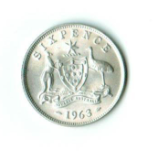In the early part of Dad and Mum’s lives, the Imperial systems were used for money, weight, length, volumes and temperatures, as well as for other measures. All this began to change in the 1960’s when the metric system began to be introduced in Australia. Some of the new metric measures were embraced quickly, particularly by the young and in those systems more frequently used. However other systems were slower in being taken into general use, e.g., farmers and real estate agents still frequently give the area of a farm or particular paddock in acres and not hectares. The same also applies for distance.
Currency
One of the biggest change came with the introduction of decimal currency which occurred on 14 February, 1966 – instead of pounds, shillings and pence we had to learn and understand about dollars and cents. Half a pound or ten shillings became a dollar and formed the base unit of the new currency. It was divided into 100 cents. The pound was the previous basic unit with 20 shillings or 240 pence to the pound.
In hindsight it is little wonder that a considerable amount of time was taken up in the class room to master the old system
Pre-decimal coins and their relative values are as follows:-
4 farthings = 1 penny
2 half pennies = 1 penny
12 pennies/pence = 1 shilling
4 threepences = 1 shilling
2 sixpences = 1 shilling
20 shillings = 1 pound
1 florin = 2 shillings
1 half-crown = 2 shillings and six pence
1 crown = 5 shillings
4 crowns = 1 pound
40 sixpences = 1 pound
80 threepences = 1 pound
240 pence = 1 pound
1 sovereign = 1 pound
1 guinea = 1 pound and one shilling
At change over to decimal currency, notes in use were those of ten, five, two and one pounds plus a ten shilling note with coins being two and one shillings, sixpence, threepence, penny and a half-penny, although the latter by then having little value, was rarely used. Other coins at an earlier time included the gold coins of sovereign and half-sovereign, the silver crown and the copper farthing.
With the coming of decimal currency the notes on issue were twenty, ten, five, two and one dollars. Since then fifty and a one hundred notes have been introduced and the two and one dollar notes withdrawn, the latter being replaced with coins. A change to the fifty cent coin has also occurred, the original round silver coin being withdrawn and being replaced with a twelve sided cupro-nickel coin. The copper two and one cent coins have also been withdrawn.
The change to decimal currency brought an end to a long held and much cherished Christmas tradition, that of placing threepenny coins in the pudding. It held out the exciting prospect of gaining some extra pocket money which in those days was often limited. Therefore, Christmas pudding was rarely refused by the kids and it was always exciting when coins were found in ones pudding. These were carefully set aside with a tally up and report given at the end of the meal.
The practice ceased mainly due to the type of metal used in the coins, the new metal supposedly being unsuitable for use with cooking ingredients. The withdrawal of the threepenny coin was probably a further reason.
Length
The terms and values were just as complicated as those of currency and were:-
12 inches (ins.) or ( ”) = 1 foot (ft.) or ( ’)
3 feet = 1 yard (yd.)
22 yards = 1 chain (chn.)
5 ½ yards = 1 rod, pole or perch
25 links = 1 rod
4 rods = 1 chain
100 links = 1 chain
10 chains = 1 furlong (fur.)
8 furlongs = 1 mile (m.)
80 chains = 1 mile
1760 yards = 1 mile
5280 feet = 1 mile
Title deeds gave measurements for length in chains and links and areas in acres. A cricket pitch was 22 yards or one chain and to help us to remember it, were taught the following ditty – “From wicket to wicket in cricket is 22 yards or one chain”. Even though the measurements appear complicated, yet in a way were practical, for a yard was a good stride.
WEIGHTS (Avoirdupois weight)
16 ounces (oz.) = 1 pound (lb.)
14 pounds = 1 stone
28 pounds = 1 quarter (qr.)
4 quarters = 1 hundredweight (cwt.)
112 pounds = 1 hundredweight
20 hundredweights = 1 ton
2240 pounds = 1 ton
(Troy weights – for weighing gold and silver)
24 grains (gr.) = 1 pennyweight (dwt)
20 pennyweights = 1 ounce (oz.)
60 pounds of wheat = 1 bushel
40 pounds of oats = 1 bushel
Volume (or liquid measure)
Pints and gallons were the terms most frequently used with others to a lesser degree
4 gills = 1 pint (pt.)
2 pints = 1 quart (qt.)
4 quarts = 1 gallon (gal.)
8 pints = 1 gallon
31 ½ gallons = 1 barrel
2 barrels = 1 hogshead
6 ¼ gallons = 1 cubic foot
1 gallon of pure water weighs 10 pounds
Oil and fuel was mostly distributed in 4 gallon tins or 44 gallon drums.
Temperature
Temperature readings were also converted to the metric system with the new term adopted being Celsius. Previous readings were given from the Fahrenheit scale –
Fahrenheit Celsius
Freezing point (water) 32 0
Boiling point (water) 212 100
Conversion Factors

Other terms in use, a dozen or 12, a baker’s dozen, 13, a score 20 and a grosse, 144.

